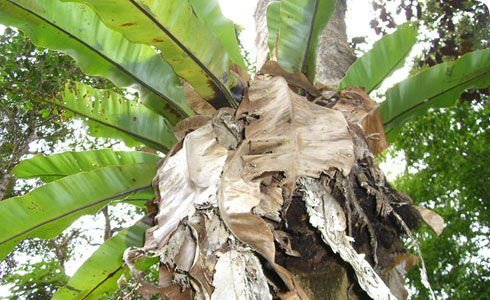Canopy ecology
Rainforest canopies are known to be rich in animal life. However, we are only just beginning to understand how bird’s nest ferns contribute to the structural complexity of the canopy, and how that in turn may help to support forest biodiversity.
The ferns provide important feeding and nesting resources for many animal species that spend all or part of their lives in the canopy.
The organic matter in the fern remains damp and is therefore a suitable refuge for many species that may not tolerate the harsher climatic conditions that occur in the canopy.
When the outer fronds turn brown and die, they hang down forming a thick skirt below the fern - a second area within which more animals live.
In Borneo, researchers found that 6 large ferns had an average of 41,000 invertebrates living in them. These included:
- colonies of ants and termites
- up to 15 other orders of insects
- earthworms
- spiders and scorpions
- centipedes and millipedes
- woodlice
- snails
Amphibians, reptiles and small mammals such as squirrels and bats have also been recorded from bird’s nest ferns.
Estimates suggest that a single large fern may contain as much invertebrate biomass (the weight of all the invertebrates) as found in the whole of the rest of the tree crown in which the fern grows. There are probably as many species living in the ferns as are found in a similar sized area of the forest floor.
